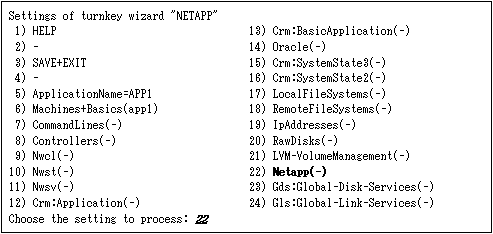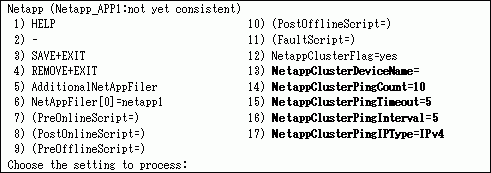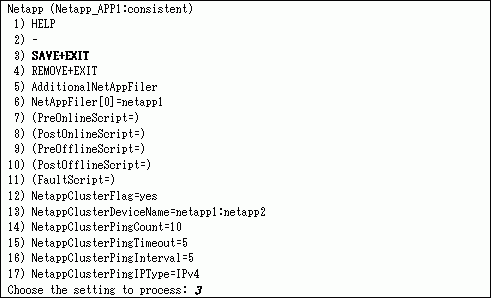When you return to the NETAPP turnkey wizard, select Netapp.

When the Netapp wizard is displayed, select AdditionalNetAppFiler.

When the following menu is displayed, select FREECHOICE and enter a host name for NAS.

When the following menu is displayed, select AdditionalExportpoint.

When the following menu is displayed, select FREECHOICE and enter a volume to be exported.

The following menu is displayed. If you have any further volumes to be exported, select AdditionalExportpoint to add.

The following operations are available from the above menu:
Attributes | Description |
UnLockFlag | Select whether or not Unlock processing should be executed on NAS. |
ExportFlag | Select whether or not Export processing is executed during Online processing. |
UnExportFlag | Select whether or not Unexport processing should be executed during Offline processing in standby operation. |
ScriptTimeout | Specify timeout period (sec) for launching of Online/Offline processing. Normally, you do not need to change the default value. |
If addition is complete, select SAVE+RETURN.
You return to the Netapp Wizard. If you want to add any further NAS units, select AdditionalNetAppFiler.
It is set for script files in Netapp resource also start and stop. If it is not necessary, go to next step.

Attributes | Description |
PreOnlineScript | Executed before Online processing. |
PostOnlineScript | Executed after Online processing. |
PreOfflineScript | Executed before Offline processing. |
PostOfflineScript | Executed after Offline processing. |
FaultScript | Executed when a fault occurs. |
See
For further details, see the "PRIMECLUSTER Reliant Monitor Services (RMS) with Wizard Tools (Solaris, Linux) Configuration and Administration Guide".
Next, it is set for PRIMECLUSTER to control the NAS cluster if necessary. In the cluster composition of the NAS device, if network failure between the cluster node and the NAS device is detected PRIMECLUSTER Wizard for NAS can execute failover (cf takeover) of the NAS-Cluster.
Selects NetappClusterFlag=no for monitoring the NAS-Cluster.

Attributes | Description |
NetappClusterFlag | It is set for control facility of the NAS-Cluster. |
Note
Default is no. NetappClusterFlag select no if control facility of the NAS-Cluster is not necessary, when you use a clustered NAS.
If you use NAS-Cluster, select yes.

Set parameters.

Attributes | Description |
NetappClusterDeviceName | The NAS device name (host name) is specified. |
NetappClusterPingCount | The execution frequency of the ping / ping6 command is specified. |
NetappClusterPingTimeout | The time-out time (sec) for launching of the ping / ping6 command is specified. |
NetappClusterPingInterval | The execution interval (sec) of the ping / ping6 command is specified. |
NetappClusterPingIPType | The type of IPaddress of the ping / ping6 command to NAS device is specified. Default: IPv4 (IPv4, IPv6) |
Note
These attributes is set for each userApplication.
The NAS device is monitored by the ping / ping6 command. When IPv4 is specified by NetappClusterPingIPType, the ping command is used. When IPv6 is specified by NetappClusterPingIPType, the ping6 command is used. Verify that the access to the NAS device is possible by the type of IPaddress of NetappClusterPingIPType. For details, refer to "2.4 NAS configuration"
It is recommended that the value of NetappClusterPingCount, NetappClusterPingTimeout, and NetappClusterPingInterval is default.
Do not mix the NAS device name of IPv4 and NAS device name of IPv6 in NetappClusterDeviceName.
See
Refer to "Appendix B Turning of the control facility for the NAS-Cluster" for the parameter of the ping / ping6 command.
When the setting is completed, SAVE+EXIT is selected.
